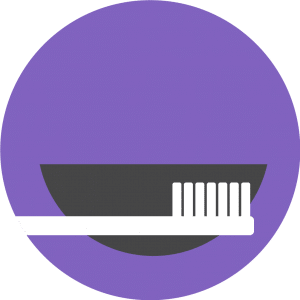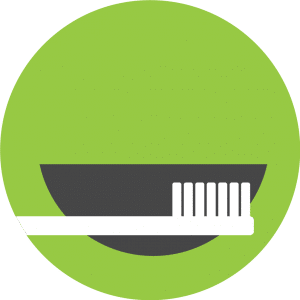Pediatric Dentistry
Services

Infant & Child Oral Care
Caring for Gums
Development
Brushing & Flossing
Tips for Parents of Infants and Children
Caring for Gums
Begin building good oral health habits at birth by cleaning your baby’s gums with a soft infant toothbrush or a cloth and water after breast- or bottle-feeding.
Development
From six months to age 3, your child may have tender gums when teeth erupt. Many children like a clean teething ring, cool spoon or a cold wet washcloth. Your baby’s first tooth usually appears around seven months of age. This is when you should begin brushing your baby’s teeth with a toothbrush and toothpaste.
Brushing and Flossing
As soon as the teeth begin to appear, start brushing twice daily using fluoridated toothpaste and a soft, age-appropriate sized toothbrush. Use a “smear” of toothpaste for a child less than 2 years of age. For the 2-5 year old, dispense a “pea size” amount and perform or assist your child’s tooth brushing. Children should spit out and not swallow excess toothpaste after brushing. Flossing is recommended once a day when the child’s teeth are touching or are in contact with each other.
Set a good example by letting your child see you brush and floss your teeth. Starting these daily habits at a young age will help to prevent tooth decay.

Prevention
Regular Check-Ups
Avoiding Cavities
Tips for Parents for Keeping Your Children's Teeth Healthy
Regular Check-Ups
The American Dental Association recommends that you, and your child, visit the dentist every six months for regular checkups and routine teeth cleanings. Regular dental visits help your child to maintain a bright and healthy smile. During the check-up, the pediatric dentist will review your child’s medical and dental history and gently examine your child’s teeth, oral tissues and jaws. The teeth will be cleaned and polished and topical fluoride will be applied.
Avoiding Cavities
Brush your child’s teeth for them at least two times a day, recommended up to age 12!
Floss your child’s teeth once a day, when they are touching or in contact with each other.
Serve your child a balanced diet, limiting daily exposures to sugar rich drinks and treats.
Limit snacking and only drink water between mealtimes.
Visit the dentist for regular check-ups and cleanings after the first tooth appears.

Treatment
Sealants
Fillings & Crowns
Root Canals & Extractions
A Few of the Ways That We Can Help
Sealants
This is a preventive technique used to reduce the chance of cavities on the top surface of permanent molars. A white, plastic-like material is placed on the surface of the tooth to seal the grooves of the back permanent molars. Sealants have shown to reduce the chance of cavities by 60-65%.
Composite Resin Fillings
Composite is a tooth colored filling material. It’s greatest advantage is that it matches the existing teeth so well. This material does not do as well for large restorations on back teeth because they tend to fracture over time. We choose composite when performing fillings on front teeth or small fillings on the back teeth.
Stainless Steel Crowns
These are silver caps that cover the entire surface of the tooth. Although they are silver it is important to know that these crowns do not contain mercury like amalgam fillings. The greatest advantage of this type of restoration is its strength and longevity, which is why we choose stainless steel crowns for large cavities on the back teeth.
Baby Root Canals
When bacteria from cavities reach the nerve of primary teeth, it is important to remove the nerve of the tooth to avoid the chance of an abscess. Sometimes we remove only the top part of the nerve, a Pulpotomy, and sometimes we remove the entire nerve, a Pulpectomy. Once the nerve is removed, material is placed to calm the nerve prior to the final restoration. Our Lynchburg dentist office specializes in these types of procedures.
Extractions
Sometimes extracting the tooth is the best or only option for treatment. Indications for extraction can include: request by an orthodontist; abscessed teeth; teeth with large cavities that can’t be restored or teeth with cavities that may be coming out soon, due to the child’s age.
Space Maintainers
These retainers are used to avoid space loss or crowding which can result from having a primary tooth extracted too early. The spacer is glued into place and stays until the permanent tooth is ready to come in; at that point we remove it. Space maintenance isn’t typically needed for front teeth.
Sedation Dentistry
There are three types of sedation dentistry. Inhalation (known as laughing gas) and oral conscious sedation are both performed in our office. General anesthesia is performed at Virginia Baptist Hospital and is reserved for some children with special needs or those requiring extensive dental care.
Nitrous Oxide
Otherwise known as laughing gas, is a technique used to reduce anxiety, produce analgesia, and enhance effective communication. The technique is provided in our Lynchburg dentist office and is inhaled from a mask placed over the patient’s nose. Nitrous oxide does not make your patient fall asleep and the effects of the gas wear off before your child gets up from the dental chair.
Oral Conscious Sedation
Is a technique that uses various medications to induce a depressed level of consciousness. The patient retains the ability to maintain a patent airway and is continuously able to respond appropriately to physical stimulation and/or verbal commands. Conscious sedation is provided in office, the medications are usually taken orally, and the appropriate monitors are used.
General Anesthesia
Is a controlled state of unconsciousness that eliminates awareness, movement, and discomfort during dental treatment. A physician with specialized training can use various medications to provide general anesthesia, in a hospital setting, for patients receiving dental care. General anesthesia services are provided at Virginia Baptist Hospital and are monitored by a General Anesthesiologist. The dental treatment is provided by one of our pediatric dentists.
General anesthesia may be recommended for children with extensive dental needs who are uncooperative, fearful or anxious or for the very young who do not understand how to cope. It can also be helpful for children requiring significant surgical procedures or patients having special health care needs.
